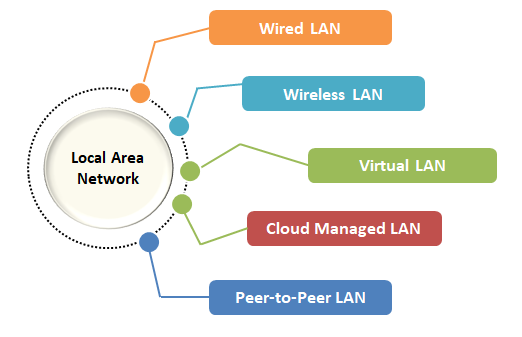What is Local Area Network (LAN)?
A local area network is a network that connects computers and other devices within a limited geographic area, such as a home, Office or campus. Resources such as files, printers, and internet connections are most commonly shared among connected devices using a local area network. High-speed communication is facilitated by a local area network, making it an essential component of modern networking.
Main Features of (LAN)
Limited Geographic’s Range: A (LAN) can typically cover a small area such as a single building or a group of adjacent buildings.
High Data Transfer Speed: A (LAN) offers high speed communication with data transfer rates ranging from 10 Mbps to 10 Gbps or even more de pending on the technology used.
Shared resources: Devices Connected to a local area network can share hardware such as printers and scanners as well as software and files.
Centralized Control: Many (LAN) use a central server or administrator to manage resources and maintain security.
Connectivity: The use a variety of technologies to connect devices, including Ethernet, Wi-Fi and fiber optic cables.
Local Area Network Components
- Computers and Devices
This includes desktops, Laptops, Smartphones, Printers and other network-enabled devices.
- Networking Hardware
Key hardware includes the Following:
Switches: Devices that can connect multiple devices within a local area network and manage data traffic efficiently.
Routers: Devices that can connect a local area network to external networks such as the internet.
Access Point: Used in wireless(LAN)to provide connectivity to Wi-Fi enabled devices.
- Cabling and Connectors
Ethernet cables, fiber optic cables, connectors are used in wired local area network to connect devices.
- Software(LAN)
This includes network management software, Operating system and protocols such as IP/TCP that enable communication between devices.
Type of (LAN)
- Wired Local Area:
Uses physical cables to connect devices. These are widely known for their stability and speed.
- Wireless Local Area Network:
Wi-Fi technology is widely used to connect devices without physical cables. Wireless Local Area Network offer ease of portability and installation, but can be slower than wired (LAN)
- Virtual( LAN)
A local grouping of devices within a local area network that allows them to communicate as if they were on the same physical network even if they were not.
- Cloud-Managed
Cloud-managed (LAN) are a network infrastructure where devices such as switches, access point and routers can be centrally managed through a cloud-based platform. If offers easy administration remote monitoring and scalability without the need for onsite hardware controllers.
- Peer to Peer:
The peer to peer model is a peer to peer networks model where devices called peers communicate directly with each other to share resources or data without relying on a central server. It is commonly used in file sharing block chain and distributed computing applications.
Advantage
Resource sharing: Printers files and applications are shared efficiently.
Cost Speed: Reduces the need for individual hardware by sharing resources.
High Speed: Provides high speed data transfer rates for connected devices.
Disadvantage of (LAN)
Limited coverage: Limited to a small geographic area.
Initial Setup Costs: Requires a lot of investment in hardware and setup.
Maintenance: Regular updates and troubleshooting are essential.
Conclusion
A local area network is a cornerstone of modern computing that enables efficient multi-head communication and resource sharing in confined spaces. With advancement in technology LANs continue to evolve, offering even greater speed security and connectivity options. Whether wired or wireless LANs play a vital role in homes businesses and institutions worldwide.






Leave a Reply